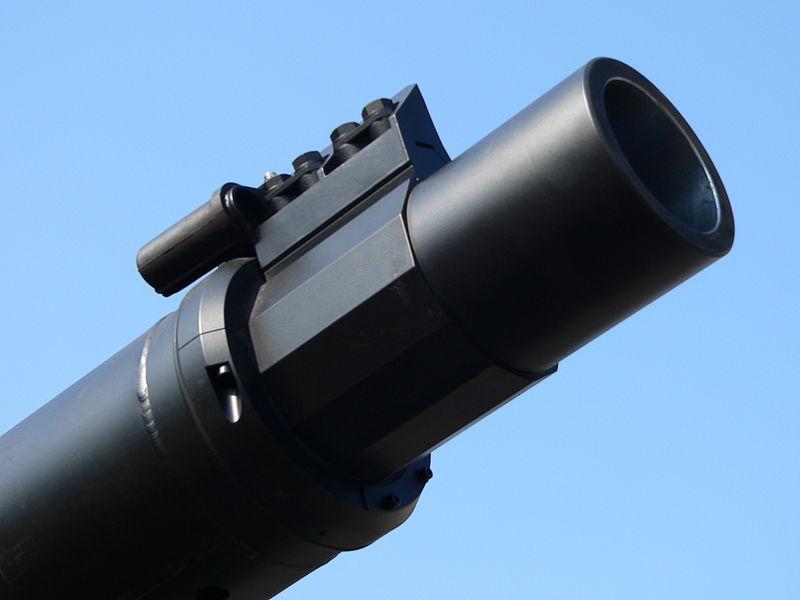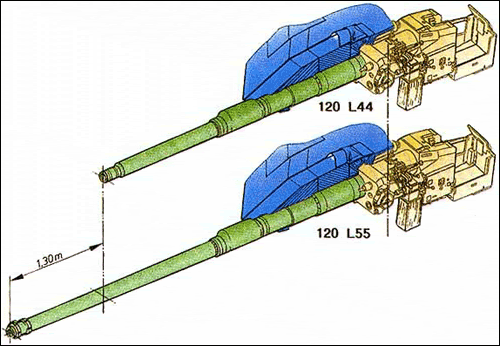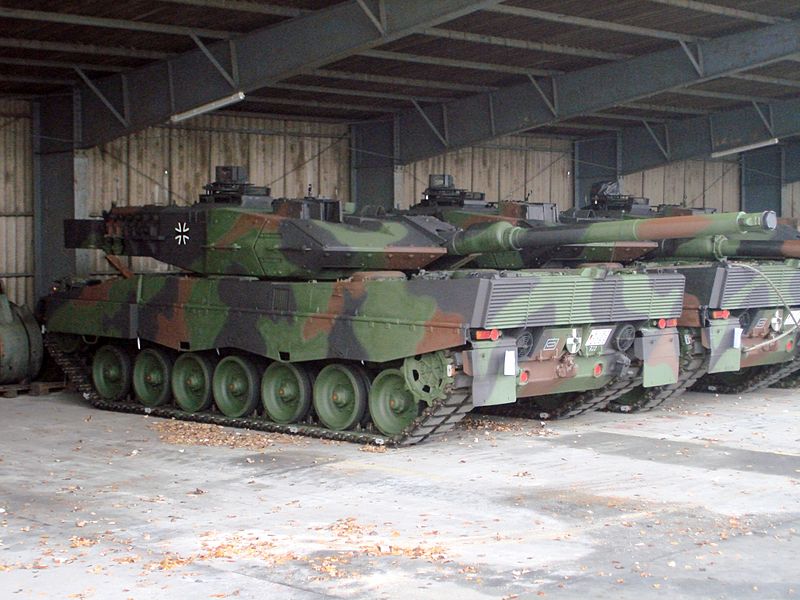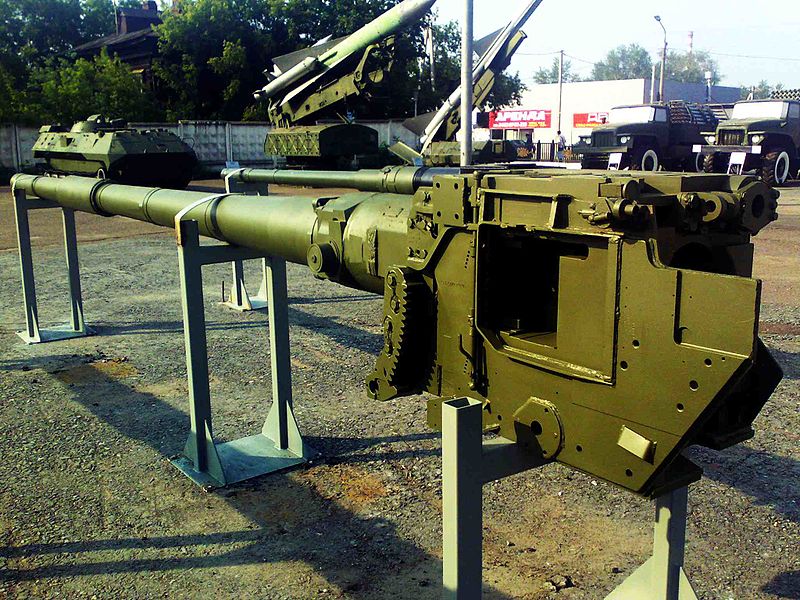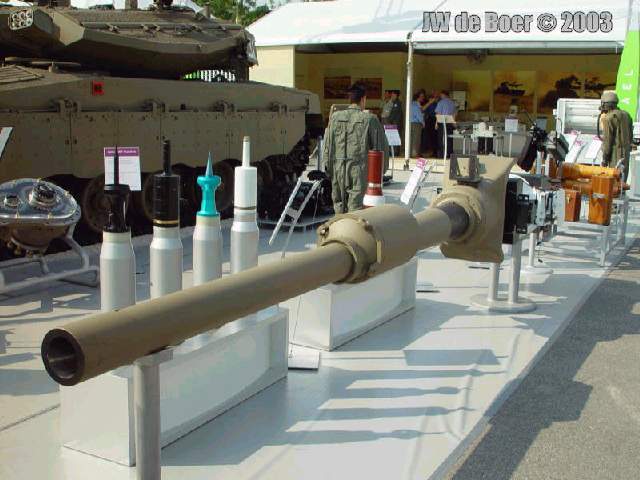---------------
The GIAT CN120-26/52 is a French 120 millimetre tank gun of 52 calibres. It is the primary gun of the Leclerc main battle tank. The bore is smoothed and chromed. The gun is fed by a mechanised loader that allows a rate of fire of 12 shots per minute.
GIAT CN120-26/52 - Wikipedia, the free encyclopedia
-------------------
Tanque Argentino Mediano
The new tank's firepower requirements were met by fitting a British Royal Ordnance L7A1 105 mm (4.13 in) main gun. This gun was later replaced by the modified L7A2 and finally by Rheinmetall's Rh-105-30 105 mm (4.13 in.) gun. This gun is manufactured in Argentina as the FM K.4 Modelo 1L. The Rh-105-30's advantages include low weight, compact size and increased lethality.
TAM (tank) - Wikipedia, the free encyclopedia
Rheinmetall's Rh-105-30 105 mm
The basic component of the Rheinmetall 105 mm rifled tank family is the Rh 105-60, a development of the British Royal Ordnance L7 series capable of firing the normal group of 105 mm tank gun ammunition.
Army Guide - Rh-105-60, Gun
-----------
Large Caliber Tank Guns for Lightweight Platforms
The gun versus armor dilemma regarding the evolution of tank design has catalyzed a trend to increase gun caliber in order to enhance lethality. Tank technology has witnessed this trend since the beginning of tank warfare during the First World War, but truly began to take-off in the late-1930s. For example, during the Spanish Civil War national Panzer Is, supplied to Franco’s forces by Hitler’s Third Reich, found themselves outgunned by the Soviet Union’s larger T-26s. Although during the opening armor clashes of the war during the Battle of Madrid Panzer Is found it suitable to use 7.92mm armor-piercing ammunition at a maximum of 150m range, Republican T-26s responded by engaging at longer ranges, up to 1,000m. The Panzer I’s light 7.92mm MG13 machine gun was not capable of penetrating the T-26’s steel armor plating at long-.ranges, while the T-26 could easily engage and defeat the Panzer I at almost a kilometer using their 45mm high velocity artillery cannons. Consequently, the National Front attempted to exchange the armament with an Italian 20mm model 35 anti-aircraft gun, which could penetrate 40mm of steel at 250m range. There were even attempts to fit a Panzer I with 37mm and 45mm anti-tank guns, although these failed at the drawing board. 1 The process of increasing lethality continued during the 1930s, to the point where Germany’s Panzer IIIs were armed with 37mm tank guns. During the Second World War, the process of increasing gun caliber escalated and six years of war saw the evolution of the tank gun from 37mm to up to 128mm! 2
The end of the war saw the division of the world into two separate camps, led by the United States and by the Soviet Union. The West consolidated unto one caliber – the 90mm gun which was mounted on the Pershing tank and early modernizations thereof (M46, M47 and M48, for example). The Soviet Union left the war with the 122mm gun on the Stalin tank series, and the 85mm gun on their T-34/85s. Although some prototypes of the T-44 were armed with 100mm guns (and others with 122mm guns), the first series mass production of a 100mm armed tank began with the T-54 in 1947. 3 NATO’s L7 rifled 105mm gun, of British design, was adopted due to a first-hand glimpse of the tank when a Hungarian rebel drove a T-54 onto Budapest’s British embassy. 4 The cold war saw a slower pace of gun evolution, but the Soviets quickly introduced the 115mm tank-gun on early versions of the T-64, when an Iranian M60 defected to the Soviet Union, and then a 125mm gun thereafter. NATO continued to use the 105mm gun until the late 1970s when the Leopard 2 began series production with Rheinmetall’s 120mm L/44 tank gun. It should be noted that there were heavy tank designs in both the Soviet Union and the West with 122mm and 120mm tank-guns, but these are a different class of vehicles and were not produces on the same scale as medium tanks. Although the United Kingdom decided to go with the L11 rifled 120mm gun on the Challenger main battle tank (the same gun which was fielded on their Chieftain), the 120mm caliber in general took over the 105mm in all NATO tank-producing countries (United Kingdom, Germany, Italy and the United States) by the mid-1980s. Since then, there has been no enlarging of caliber and instead nations are focusing on improving the 120mm tank gun with revolutionary technologies.5,6No nation has employed the mythical 135mm and 140mm tank-guns in a series-production vehicle to date.
The fall of the Soviet Union in 1991 marked the beginning of new defense policies in NATO. Large and heavy main battle tanks were no longer considered relevant for national defense, and with the demise of the colossal Soviet Army large tank fleets became hard to justify given the required costs of maintenance and procurement. As a direct consequence, several future tank programs were cancelled – such as the Leopard 3 and the Block III Abrams. Instead, nations have begun to focus more on the development of air mobile resources to quickly deploy to trouble spots. These requirements have been magnified with recent operations in Bosnia, Kosovo, Lebanon, Afghanistan and Iraq. Although nations like the United States still perform large-scale invasions (Iraq 1991 and Iraq 2003), most armies no longer require the shock effect of heavy tanks and instead have to focus on easily deployed, yet still powerful airmobile vehicles. The problem is that infantry combat vehicles such as Spain’s Pizarro or Sweden’s CV90-30 don’t have the firepower for direct infantry support, like a tank does. This problem is much more evident in nations that have chosen to completely replace their tank fleet, like Belgium. As a consequence, nations have begun to develop light airmobile tanks based on infantry combat vehicle chassis.
Although such vehicles may never completely replace the main battle tank, they are much more favorable for procurement. To give a rough idea, it costs roughly five to six million euros to purchase a Leopard 2A6 in bulk, while it costs over eight million to purchase a tank which has been produced in lesser quantities (such as the Italian Ariete or the French Leclerc). 7 A future tank will cost at the very least double of what it currently costs. 8 At an early production rate, for example, the non-line of sight cannon (NLOS) will cost over twenty-five million U.S. dollars per vehicle! 9 Although, currently, a state-of-the-art light tank will cost just as much (or possibly more) than main battle tanks from the 1980s,10 they are considerably cheaper than main battle tanks of the same generation. Furthermore, their costs are more easily justified given that a light tank is designed with the ability to fit in a specified tactical transport (in Europe’s case the A400M and in the U. S.’ case the C-130 Hercules), while a main battle tank has only limited aerial transport capabilities in heavy strategic transport aircraft (such as the C-5 Galaxy).
They don’t necessarily need to be considered replacements for the main battle tank, although Belgium has replaced her Leopard 1s with wheeled Piranha armored fighting vehicles and at one point Canada was contemplating the replacement of her Leopard 1C2s with the LAV Stryker mobile gun system. Nations like the United States will mix ‘light brigades’ with ‘heavy brigades’, using them for different missions. Nations like Spain, Denmark or Germany are interested in heavy tanks like their Leopard 2A6s for national defense and for unmatched ground support in the field of survivability, but they’re also looking for lighter alternatives for quick reaction forces to quickly deploy contingents to trouble spots like Afghanistan, Bosnia or Kosovo. In that sense, the two can work in the same army. The United States has deployed mobile gun systems for direct infantry support, to work alongside wheeled armored personnel carriers. The Italian’s have procured large numbers of their Centauro armored fighting vehicles, in the twenty-four ton class, in order to perform cavalry missions and area security missions during peacekeeping operations.22 Their preference is exhibited by the large amounts of orders various nations have placed for these types of vehicles and the amount of money and time spent on further developments and upgrades.
In that sense, in the past seven years defense businesses have worked ‘night-and-day’ to provide lethality improvement options for existing and future armored fighting vehicles. One of the most important areas being developed upon is lethality, and recently several new large-caliber tank guns have been advertised for integration into lightweight armored fighting vehicles between eighteen and thirty tons. These new armaments allow light armored fighting vehicles the same lethality as a main battle tank in the sixty ton class. Understandably, large caliber high velocity cannons produce high recoil forces and the increase in recoil is exponential as gun caliber increases. Consequently, the major areas of improvement remain reducing recoil mass and force and reducing the unbalance of the gun and vehicle during firing.
105mm low-recoil tank guns
Some of the better known 105mm tank-guns are Rheinmetall’s Rh-105-20 and Rh-105-30 series, based on the British L7A3 which had been accepted for service on the Leopard 1. However, these new Rheinmetall 105mm guns have exchanged the rifling of the L7 for the smoothbore of Rheinmetall’s 120mm guns. This, in combination with the use of chromo lining along the inner walls of the barrel, allows the gun to withstand bore pressures of 680MPa, up from 525MPa. The system’s weight has been decreased to 1,550kg through the use of innovative changes in the breech design. Most importantly, the recoil force felt by the vehicle has been reduced to 150kN, allowing the gun to be mounted on armored fighting vehicles of eighteen tons or more. The reduction in recoil has been established by allowing an extended recoil mechanism length of 750mm and by adopting a Rheinmetall specific advanced pepperbox muzzle break. The muzzle break reportedly does no damage to fin-stabilized projectiles by harming the fins and reduces the noise produced through lateral gas venting. The new 105mm series of guns by Rheinmetall can fire new German 105mm APFSDS at a muzzle velocity of 1,700m/s and these rounds can penetrate up to 560mm of rolled homogenous steel (RHA) at 1km, allowing the gun to defeat the T-72’s frontal arc.12,13
The LAV Stryker mobile gun system (MGS) is currently armed with the M68A1 105mm rifled gun, based on the British L7, which have been recycled from earlier use on M1 Abrams. Early models of the gun featured a pepperbox muzzle break, but high noise production threatened the safety of dismounted infantry and as a consequence deployed Stryker mobile gun systems don’t feature a muzzle break on their M68 105mm guns. In that sense, Rheinmetall’s new smoothbore 105mm guns might present an option for a future improvement program. United Defense, now owned by BAE Systems, developed the M35 low-recoil gun for the M8 armored gun system, now defunct.14 The aluminum turret means that the recoil force imparted by the gun had to be low enough to not damage the structure. As mentioned, the M8 program was canceled in the mid-90s and has not successfully been exported. Currently, the program continues within the Lightning Bolt II and a low-recoil 120mm gun.

Perhaps one of the most interesting new 105mm gun options is Cockerill’s 105mm CV tank gun. The new gun is bedded to a new CMI turret, weighing only 4.5 tons. At 52 calibers in length, the gun keeps the same bore geometry as the British L7 and therefore is compatible with all existing 105mm ammunition for rifled guns. Recoil is reduced through a very efficient muzzle break (70% efficiency) and an extended recoil length of 580mm. That said, the recoil force is the same as Rheinmetall’s 105mm options – 150kN. Furthermore, the new turret is designed to fit inside of a C-130.15 Fired from the 105mm CV the new Mecar 105mm M1060 APFSDS has a muzzle velocity of 1,520-1,560m/s and at 2km can penetrate 510mm of rolled homogenous armor at 60º obliquity (460mm at 0º obliquity).16 The new turret may replace the 90mm gun turret currently on Belgium’s MOWAG Piranha IIIC, which replaced their Leopard 1BEs. On the Piranha the 105mm gun turret can carry sixteen 105mm rounds at ready, and the autoloader can load six to eight rounds per minute. Very importantly, the gun can elevate up to 42º in the new turret.17
Other 105mm guns have been developed around the world. The South African company Denel offers the GT3 105mm gun, weighing roughly 2,900kg. India’s Ordnance Factory Kanpur offers a 1,287kg 105mm gun to upgrade T-54s and T-55s. This new gun is based on the British L7 and is rifled, and has an effective range of 4km. BAE systems itself is offering a new improvement of the L7, now 6.66m in length and weighing only 1,334kg.18
120mm low-recoil designs
Rheinmetall, apart from their new series of 105mm guns, offer the 120mm L/47 lightweight low-recoil (LLR) tank gun. The system is designed to fit on vehicles of the twenty-five ton class and keep compatibility with A400M transportation.19 France’s Nexter has introduced their new 120mm L/52 FER (Faible Effect du Recul) low-recoil tank-gun designed to be adopted by vehicles of the twenty-five ton class, such as the future French EBRC armored car. The 120 FER has a twin-chamber muzzle brake and features a 550mm recoil length. These two guns are similar to Italy’s 120mm L/45 low-recoil tank gun designed by Oto Melara. The new pepperbox muzzle break and 550mm recoil length has reduced recoil mass to twenty-five tons, and the weapon is currently being offered for export on the Centauro 8x8 armored fighting vehicle on a new HITFIST turret. Denel offers the GT12 120mm gun for South Africa’s Rooikat wheeled armored fighting vehicle, which is currently armed with a 76mm gun. Israel will soon offer a low-recoil 120mm gun based on Slavin Land System’s MG253 for the Sabra main battle tank.20
One of the most successful low-recoil tank guns to date is Ruag’s 120mm compact tank gun (CTG). This gun is fifty calibers in length and has been improved with a muzzle break, having an efficiency of roughly 40%, and an increased extended recoil length – from 410mm to 500mm. Recoil mass has been decreased from 50 tons to 26 tons.21 Currently, Ruag’s 120mm CTG is being used to arm Jordan’s Falcon turret for their Al Hussein turret upgrade for the M60. The gun is matted to an unmanned (the crew is below the turret ring) narrow mantlet turret and a new autoloader which carries eleven rounds.22 It should be noted that the compact breech comes at a price of gained weight. Ruag’s gun system weighs 2,600kg compared to the 1,901kg of the M256 and the 1,100kg of Rheinmetall’s L/44. The same can be seen with Israel’s compact gun systems for their Sabra M60 upgrade – the M253, based on the M251 of the Merkava III, weighs 3,300kg. Currently, Norinco’s 120mm guns for possible T-55 upgrades weigh 2,600kg and France’s F1, used on the Leclerc, weighs 2,800kg.23 The Ruag 120mm CTG, originally designed for an indigenous Swedish main battle tank (ultimately canceled in favor of the Leopard 2A5), has also been chosen to arm the upcoming CV90120-T light tank, based on the CV9030 infantry combat vehicle. The system carries twelve ready-rounds and a further thirty-three can be stowed at the rear of the chassis.24
The United States is currently testing the XM291 lightweight low-recoil tank gun, originally developed in the late 1980s. Originally, the XM291 was composed of a dual-caliber breech which accepted both 120mm and 140mm ammunition. If NATO decided to accept a 140mm gun the gun tube could be exchanged for one of the 140mm diameter, making the transition cheaper. The XM291 was simply an interim solution that increased the lethality of the existing M256 by increasing the length of the gun tube and made possible the transition to a 140mm caliber.25 At some point in the late 1990s the XM291 was turned into a technology demonstrator for an electrothermal-chemical tank gun. In late 1999 the XM291 demonstrator showed that it was coming close to achieving its goal of 16MJ at the muzzle using a M289A2 APFSDS.26 Despite this enormous power, the XM291 can be mounted on the 18.7 ton Lightning Bolt II light tank, based on the M8 chassis.27 The XM36, which will see prototypes delivered by 2009, is supposed to surpass the abilities of the XM291 and will be mounted on the twenty-five ton non-line of sight cannon future combat system.28 The recent developments on the XM291 has been discussed in other Informatives.

Some considerations on large caliber guns for lightweight vehicles
Light-caliber guns have their own limitations based on the different requirements of any given armored fighting vehicle. These requirements include weight, volume, operational area, et cetera. While there may be a multitude of arrangements for a low-recoil tank gun, including high-lengths, low weights or compactness of the breech, not all of these may be useful on a certain design, depending on the criteria. If the light tank is designed to provide infantry support in an urban environment – such as Iraq – or a forested or mountainous environment – like Afghanistan – then long guns may be a detriment to the design. Longer guns limit the ability for a vehicle to turn into a narrow street, or even ride through one, given that the length of the gun might make it impossible to traverse the turret given the threat of the gun tube hitting a building. On the other hand, light armored vehicles designed to provide a nation a light anti-tank platform, like the Italian Centauro or Belgium’s Piranha IIIC, might require longer guns to allow for higher muzzle velocities and muzzle energies in order to kill enemy tanks in a one on one basis. Therefore, the length of the gun tube should be based entirely on the design requirements of the vehicle, not just to enhance lethality.
Compact tank breeches pay the price in weight, and although they’re great for lower volume turrets they can weigh two to three times the weight of a standard 120mm gun breech. It’s true that a lower volume turret will save weight in the lost armored volume, so a designer must look at all the aspects and wisely juxtapose the possible losses in armored weight and the gained gun weight. You might be surprised to find out that although you did lose weight in armor you gained it all back, or more, through the use of a 3,000kg+ tank gun. 2,000kg is what it would weigh to add appliqué MEXAS to Spain’s Pizarro infantry combat vehicle to increase protection from 14.5mm API to 30mm APFSDS, just as a reference.
In regards to recoil reduction methods, there are trade-offs. Extra room has to be made to allow for the increase in extended recoil length by 100 to 300mm, meaning that if turret roof height is kept the same in relation to the height between the turret roof and the top of the gun breech then the ability to depress will be traded-off. There has to be enough room between the end of the breech and the roof to allow for the recoil mechanism to fully extend, or else the recoil mechanism is going to end up hitting the roof itself and will damage both the gun and the tank. Muzzle breaks have a tendency to damage the fins of fin s stabilized projectiles, so they should be used with caution. The minor damage done can induce yaw on the round, decrease muzzle velocity and muzzle energy. It’s difficult to design a fire control system that takes into consideration these aspects because they can be completely random. After the round has been fired there’s no way for the fire control system to correct the path of the round, and so when yaw has been induced it can’t be fixed. However, new muzzle break technology has allowed to reduce the damage on fins, and according to Rheinmetall – as related above – the new generation of pepperbox muzzle breaks used by Rheinmetall’s current generation low-recoil guns have little to no effect on fin-stabilized ammunition. Muzzle breaks also produce high amounts of noise, which can damage the eardrums of nearby infantrymen, and so this must be taken into account when designing a fire support vehicle. As told above, the Stryker mobile gun system had its muzzle break removed due to this problem.
In other words, the real world advancements in low recoil tank guns have made it possible to play with these technologies on NationStates. But, it shouldn’t be forgotten that there are always trade-offs and prices to pay.
Limitation of light armored fighting vehicles against main battle tanks
While speaking about the comparative lethality of a light armored fighting vehicle armed with a large-caliber gun one can conclude that on the level of firepower the main battle tank has been compromised. This is somewhat true, of course, but the technology applied to these guns can be applied to main battle tanks, as well. If a 120mm gun that originally produced 50 tons worth of recoil has been improved to reduce recoil, then that recoil force can be augmented through the use of larger propellant masses – as if to achieve hypervelocity, although ideally once the maximum effective velocity is reached energy should be translated more into mass of the round. Of course, such a gun is bound to weigh more than the original given that the barrel has to be strengthened to withstand higher bore pressures from large propellants. Nevertheless, the power concepts for a similar technology smoothbore gun for a sixty ton chassis are interesting. Alternatively, low-recoil guns will allow weight decreases in main battle tanks through the adoption of better armor materials and through a smarter distribution of armored mass.
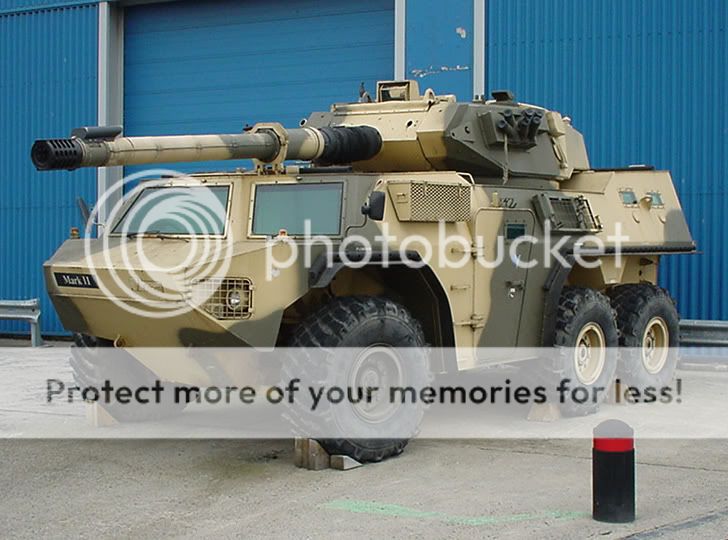
More importantly (and perhaps more realistically) light armored fighting vehicles can’t compete on the level of armor protection. Most modern infantry combat vehicles are designed to withstand hits from 30mm APFSDS, while a main battle tank’s frontal armor array is designed to withstand fire from 105mm or 120mm ammunition. All the while, modern tanks are designated hunter-killers – they have been forged as dedicated tank killing machines – and the role of the large-caliber lightweight armored vehicle doesn’t prioritize this over more pertinent missions such as infantry support. Consequently, the digital architecture of a lightweight armored gun system will be radically different from that of an advanced tank such as the Leopard 2A6 or the M1A2 SEP. In this sense, lightweight armored fighting vehicles can’t hope of taking on enemy tanks on a one-on-one basis with any semblance of parity. So, generally speaking a vehicle like the Centauro will not replace the tank in the short term. The only hopes of this will come through revolutionary technologies, such as extremely lightweight armor which will make possible armor protection levels superior to that of current sixty-ton beasts on a twenty-ton vehicle. Unfortunately, all of this also comes with increased cost penalties.
But then one can ask, what about Belgium? Belgium was the first country to procure the Leopard 1 and the first Leopard 1BEs were delivered in 1968.30 It’s possible that German defense companies were no longer able to supply spare parts to the Leopard 1, or the decreased demand as more and more nations replaced old Leopard tanks with newer Leopard 2s made it uneconomical to continue mass production of spare parts. A similar problem catalyzed Canada’s decision to purchase ex-Dutch Leopard 2A4s and Leopard 2A6s to replace their ageing Leopard 1C2s. For a country like Belgium, with little fears of getting into a war where a heavy main battle tank would be justified, Leopard 2s are too expensive to purchase and too expensive to maintain. Consequently, a light tank force makes much more sense as Belgium operates almost exclusively in peacekeeping operations. That said, these are cheaper and therefore offer a solution to nations with no interests in maintaining a large heavy tank fleet. They are also more versatile for a nation like Belgium, which requires lightweight air mobile units to deploy across large distances – not to mention, lighter vehicles which can fly on tactical aircraft like the C-130 or the A400M make more sense for the independence to deploy when wanted instead of having to use allied strategic heavy lifters.
There are probably dozens of different advantages of lightweight heavily armed armored fighting vehicles. It just requires imagination and understanding of the differences between this and a main battle tank.
Conclusions
The need for lightweight firepower has led to the development of a number of lightweight, low-recoil guns in the real world. These can provide a basis for gun development in NationStates, both for lightweight vehicles and for main battle tanks. Furthermore, it’s increasingly likely that we will see a much larger population of low-recoil guns to study from in the future.
http://z4.invisionfree.com/NSDraftroom/ar/t2071.htm









